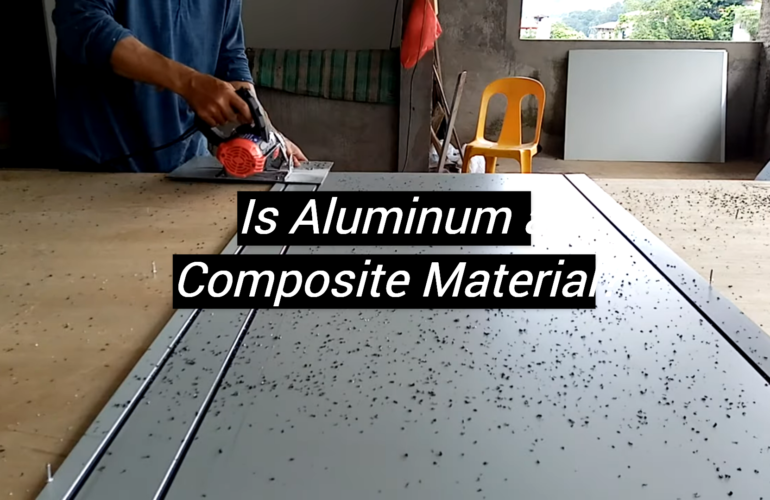When we think of composite materials, we often envisage a product made up of two or more dissimilar materials that combine to form a superior, stronger material. Naturally, the first examples that come to mind are perhaps materials such as carbon fiber reinforced plastic (CFRP) or glass fiber reinforced polymer (GFRP). However, something that you might not have considered is aluminum. Aluminum is a lightweight, versatile material that has demonstrated its strength in various applications. But is it a composite material? In this blog post, we will examine this question and consider the qualifiers that enable materials to be classified as composites.

Composite Materials: What They Are
These materials are a mix of two or more materials with contrasting properties that when combined, create a new and superior material. All these materials are usually divided into three categories – Metal Matrix Composites (MMCs), Polymer Matrix Composites (PMCs), and Ceramic Matrix Composites (CMCs). PMCs are the most commonly used composites, primarily composed of a reinforcement material and a binding matrix material.
The unique properties of these materials are their advantage. They can be tailored to meet specific needs in a number of different spheres. The most well-known features of composite materials are thermal stability, durability, resistance to corrosion, and fatigue resistance.
Because of their features, these materials are finding their way in various industries. In aerospace, PMCs are used to manufacture lightweight yet sturdy structures, reducing overall fuel consumption. In automotive manufacturing, composites are used to make parts such as body panels, spoilers, and interior components. In addition, composite materials are also being used in the construction industry for their durability and strength.
As the world continues to fill with technological advancements and innovation, composite materials play a crucial role. With automation and modern production techniques, manufacturing composite structures has become easier, faster, and more inexpensive. Hence, we can expect to see an increase in the application of composite materials across many industries, especially aerospace, marine, and renewable energy.

Composite materials have become an essential part of modern-day engineering, revolutionizing the world of manufacturing and construction. With their characteristic features, such as enhanced strength, corrosion-resistance, and flexibility, composite materials are superior to traditional materials, including steel and concrete. The increasing demand for lightweight, sturdy, and eco-friendly materials bodes well for composite materials, as we expect to see a surge in their usage in the coming years. As technology continues to advance, and manufacturing techniques improve, composite materials’ potential for versatility and innovation will continue to expand its applications.
Aluminum and Its Properties
Aluminum is a lightweight but sturdy metal that has become an essential building material in the modern world. Its abundance, low cost, and unique properties make it a go-to material in a big number of various industries, such as packaging, transportation and construction. Let’s delve into the properties of aluminum and uncover why it’s a crucial material.
- Lightweight but strong: Aluminum is three times lighter than iron, and this makes it an ideal choice where weight reduction is critical, such as in aircraft and automobiles. At the same time, the metal demonstrates remarkable strength and durability, with the ability to withstand tensile and compressive forces. This property makes aluminum desirable in construction and infrastructure projects where strength and weight are both essential. [1]
- Corrosion-resistant: Aluminum resists corrosion perfectly, thanks to the formation of a thin oxide layer on the surface. Unlike iron and steel, which corrode quickly on exposure to air and moisture, aluminum can resist rust and corrosion, making it a durable and long-lasting material for outdoor applications. This really important feature also means that the metal is ideal for use in food packaging, where it prevents contamination and spoilage. [1]
- Malleability and Ductility: Aluminum is highly malleable and ductile, meaning it can be manipulated into a variety of shapes and sizes. This property makes it a popular material in engineering and manufacturing, where it’s used to produce different parts and components. The metal can be rolled, drawn, stamped, and extruded, making it easy to fabricate and customize. [1]
- Electrical and thermal conductivity: Aluminum can conduct heat quickly and evenly, making it ideal for heat exchange applications, such as in refrigeration systems and air conditioning. The metal has high electrical conductivity, making it a popular choice as electrical transmission lines.
- Recyclability: Another critical property of aluminum is its recyclability. Unlike most metals, which degrade during the process of recycling, this metal preserves its properties, that’s why it is a cost-effective and sustainable choice. Recycling aluminum saves up to 95% of the energy required to produce new metal from raw materials, it proves that aluminum is an environmentally-friendly option for sustainable practices.

Aluminum is a versatile and essential metal with unique properties that make it a preferred material in different industries. Its lightweight, ability to resist corrosion, malleability, strength, electrical and thermal conductivity make it a perfect option for construction, transportation, and packaging applications. Additionally, its recyclability makes it one of the most sustainable and eco-friendly metals on the planet. As we continue to face new challenges and demands, aluminum will undoubtedly continue playing a critical role in shaping the modern world. [1]
Is Aluminum a Metal or a Composite?
Despite being so prevalent, many people have doubts and questions about the nature of aluminum. First things first, let’s address the most common question – is aluminum a metal or a composite? Well, the answer is that aluminum is a metal – specifically, it belongs to the group of lightweight metals that are known as nonferrous metals. But why do people sometimes refer to aluminum as a composite? It’s because aluminum is often combined with other materials to create composites that have specific properties. For instance, aluminum can be combined with carbon, glass, or ceramic fibers to create composites that have high strength, stiffness, and durability. However, the base material of aluminum remains a metal. [2]
Now that we have established that aluminum is a metal let’s dive deeper into its atomic structure and properties. Aluminum belongs to the chemical group of metals that have a high electrical conductivity, luster, and ductility. Its atomic number is 13 on the periodic table, it means that its nucleus has 13 protons. An atomic mass of aluminum is 26.98, and its electrons are arranged in three shells. The metallic properties of aluminum make it highly useful in applications that require electricity or conductivity, such as wires, electrical panels, and certain types of machinery.

Another fascinating aspect of aluminum is its abundance and availability in nature. It is important to note that nearly 8% of the crust is composed of aluminum. Aluminum is primarily derived from bauxite ore, which is found in various parts of the world, including Australia, Guinea, and Brazil. The extraction of aluminum from bauxite involves several stages of processing, including mining, refining, smelting, and casting. The overall process is energy-intensive, but the end product is highly valuable and can be applied in a number of different spheres.
Finally, let’s touch upon the ecological aspect of aluminum. The production of this metal needs a significant amount of resources and energy, but it is a recyclable material that can be reused forever. By recycling aluminum, we can conserve energy and reduce waste.
Aluminum is a metal that has a multitude of properties that make it highly useful in a variety of applications. Despite being lightweight, aluminum is strong, durable, and electrically conductive, making it an excellent choice for industries like automotive, aerospace, and electronics. While it is sometimes combined with other materials, aluminum remains a metal at its core. So, the next time you come across aluminum, remember that it is not a composite but a unique and versatile metal that has impacted our modern world in numerous ways.
FAQ
Is aluminum a metal composite?
A composite material is one that includes two or more materials with non-identical properties. In this case, aluminum can be classified as a metal composite since it comprises several elemental metals. Pure aluminum has a specific gravity of 2.7 g/cm3 and a melting point of 660.37°C. When aluminum is alloyed with other metals such as copper, zinc, or magnesium, it forms a new metal alloy that possesses contrasting chemical and physical properties than pure aluminum. For instance, the aluminum alloy 2024 consists of 90% aluminum, 4% copper, and 6% magnesium, making it stronger and more durable than pure aluminum.
Aluminum can be classified as a metal composite due to its intrinsic properties. Its anisotropic nature, manufacturing processes, and alloying with other metals make it a composite material that exhibits diverse mechanical properties. Moreover, its ability to be used in hybrid materials in various industries further strengthens its position as a metal composite. As such, understanding the nuances of aluminum can help individuals correctly interpret its capabilities in diverse applications.
Is aluminum cheaper than composite?
While both materials can be used for similar projects, aluminum is generally cheaper than composite. The average cost of aluminum per pound is around $0.75, while composite can cost anywhere from $3 to $7 per pound. This significant difference in price can add up quickly for larger projects.
When comparing the costs of aluminum and composite materials, aluminum is generally the cheaper option. However, composite materials offer other benefits, such as high strength and durability, which may make it a better choice for certain projects. Ultimately, the decision will differ in dependance on the requirements of each individual project. When weighing the benefits and drawbacks of each material, it is essential to consider factors beyond price, such as strength, durability, maintenance, repair, and environmental impact. Whether you choose aluminum or composite, it is essential to choose a trustworthy supplier to ensure that you get the best quality materials for your project.
Can an alloy be a composite?
It’s crucial to see the differences between composites and alloys. Although alloys are made of different metals, they don’t have a uniform distribution of material, unlike composites. When considering the properties of materials, both alloys and composites have unique characteristics that make them desirable for different applications. This understanding is crucial for engineers and manufacturers as they look to select the best materials for their projects. Remember, an alloy is not the same as a composite, but they are both valuable materials with useful features.
What are 5 uses of aluminum?
One of the primary uses of aluminum is in the construction industry. It is often used in the form of architectural aluminum, which is a sturdy material that is generally used for curtain wall systems, as well as for doors and windows.
Aluminum is really popular in the transportation industry, particularly in the production of automobiles and airplanes. It is used in the form of aluminum alloys, which are a combination of several metals, including magnesium, copper, and zinc. These alloys are used for their strength, stiffness, and low weight, which helps to improve fuel efficiency and reduce emissions.
This metal is also really necessary in the packaging industry. Aluminum foil is often used in packaging different foods. It is also perfect for use for cooking and baking, as it has great heat conductivity.
Aluminum is also used in the production of electronics, particularly in the form of aluminum heat sinks. They help to prevent electronic components from overheating and malfunctioning. Aluminum is also used for the construction of computer cases, where its lightweight and durable nature is ideal.
Finally, aluminum is widely used in the renewable energy industry, particularly in the production of solar panels. Aluminum frames are used to support and hold the solar panels, while aluminum can also be used as part of the reflective coating that helps to improve the efficiency of the panels.
What type of material is aluminum?
First and foremost, aluminum is a metallic element. Its low density, corrosion resistance, and malleability make it a popular choice for industries ranging from aerospace to construction. Understanding the properties of aluminum and its production process can help us appreciate and maximize the benefits of this widely used material.
Why is aluminum the best material?
Aluminum is incredibly lightweight, making it easy to transport, assemble and dismantle. Despite its lightness, it is strong and harsh weather conditions and heavy loads are not a problem at all. This makes it the best material for use in a range of applications like aircraft, automobiles, and construction.
Corrosion is a major problem for most metals but not for aluminum. It is naturally resistant to corrosion, making it ideal even in conditions with high humidity or exposure to corrosive substances. It doesn’t rust, like other metals, and can be used in applications where durability is critical.Aluminum can be machined, cast, or formed into various shapes and sizes with ease. This makes it a favorite material for manufacturers when producing intricate designs or to meet specific requirements that other metals can’t match.Aluminum is a hundred percent recyclable, and the process of recycling requires comparatively less energy than other metals. The aluminum recycling process preserves the properties of the metal, reducing the extraction costs for new aluminum and reducing environmental waste. Aluminum is cheaper than other metals like steel and titanium, despite having similar mechanical properties. With its long lifespan, low maintenance costs, and recyclability it is a cost-effective option in the long run.With its recyclability and cost-effectiveness, there’s no debate that it is the perfect material with a positive environmental impact for your next project. If you’re considering a project in any of the above industries, you simply can’t go wrong with aluminum as your primary metal choice.
Useful Video: Aluminum composite panel grooving
Conclusions
The answer to the question “Is aluminum a composite material?” is no. However, aluminum does play an essential role as a matrix component in certain composite materials, such as aluminum matrix composites. Aluminum matrix composites offer unique physical properties, such as strength, lightweight, and corrosion-resistant properties, which have broadened the scope of its applications. It is clear that the use of aluminum is especially prominent in the aerospace and defense industries, where weight reduction and strength are essential for performance. While aluminum as a matrix component may not receive as much attention as other composite materials, it is still a vital component of the composite world due to the broad range of applications and unique properties it offers.
References:
- https://www.thyssenkrupp-materials.co.uk/advantages-of-aluminium.html#:~:text=Aluminium%20is%20an%20extremely%20versatile,a%20whole%20variety%20of%20uses.
- https://romeorim.com/what-are-composites/composites-vs-aluminum/







